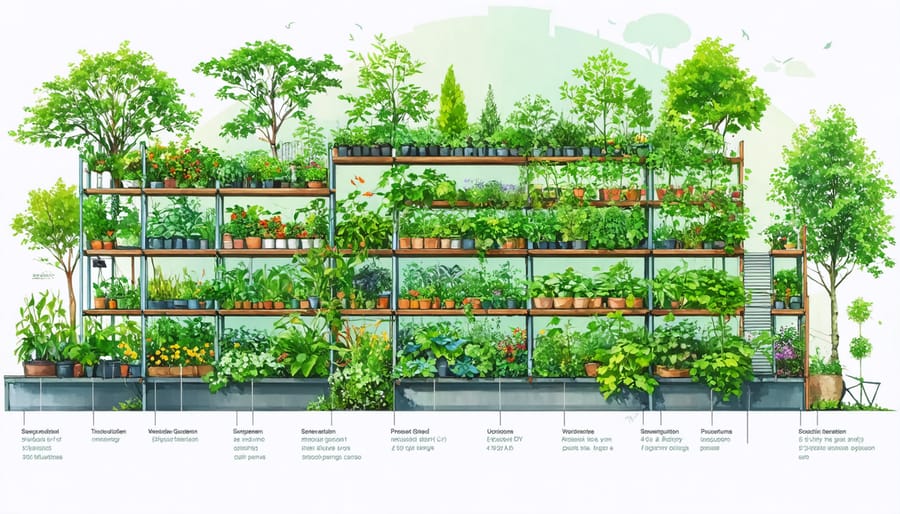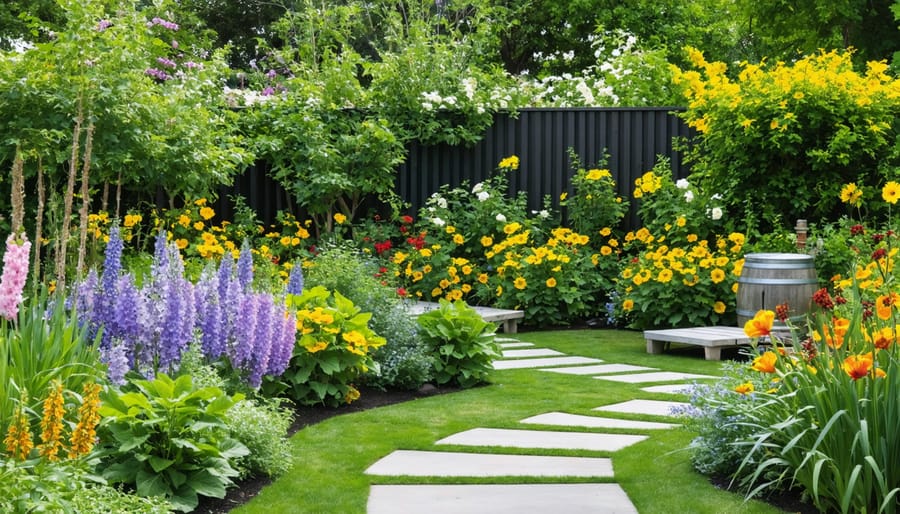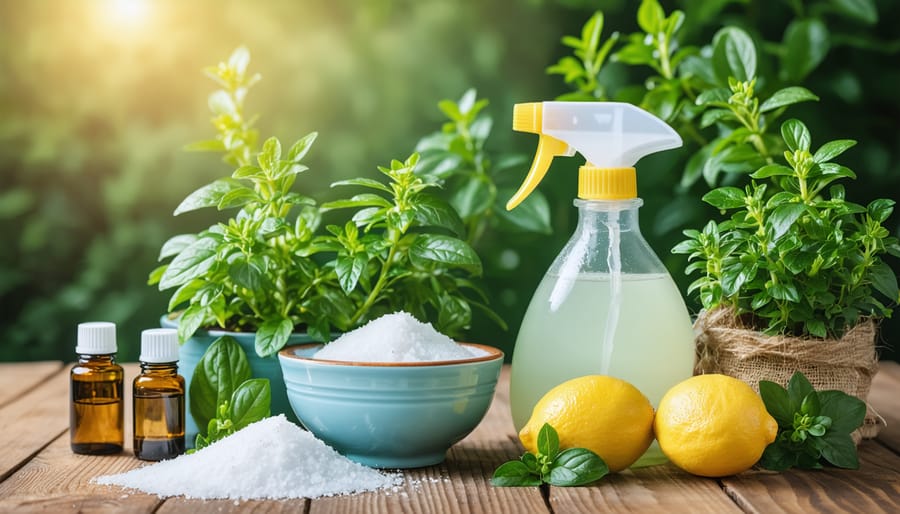Transform your garden into a thriving ecosystem by layering organic mulch 2-3 inches deep around plants, cutting water usage by 70% while naturally suppressing weeds and feeding soil microorganisms. Plant diverse companion groups – tomatoes with basil, marigolds with vegetables, and native flowers throughout – creating natural pest control corridors that attract beneficial insects and promote pollination. Collect rainwater in strategically placed barrels connected to drip irrigation systems, establishing a self-sustaining water cycle that nourishes plants with chemical-free moisture exactly when they need it.
Working with nature rather than against it dramatically reduces maintenance time while increasing garden productivity. Traditional gardening methods often deplete resources, but sustainable techniques build soil health, conserve water, and create resilient plant communities that thrive with minimal intervention. By implementing these earth-friendly practices, gardeners not only grow abundant, healthy produce but also contribute to local biodiversity and climate resilience.
This practical guide explores proven sustainable gardening methods that work in any space, from sprawling backyards to compact urban plots. Whether you’re a seasoned gardener or just starting out, these techniques will help you create a productive, environmentally conscious garden that regenerates itself season after season.
Water-Wise Gardening Techniques That Actually Work
Smart Irrigation Systems Worth Your Money
Smart irrigation systems have revolutionized the way we water our gardens, making it easier than ever to maintain a thriving landscape while conserving water. These modern solutions combine technology with environmental consciousness, offering precise control over your garden’s water needs.
Weather-based controllers are particularly impressive, as they automatically adjust watering schedules based on local weather conditions. Imagine your irrigation system automatically skipping a session because it’s been raining – that’s the kind of smart technology we’re talking about! These systems typically pay for themselves within two years through water savings alone.
Drip irrigation systems are another game-changer, delivering water directly to plant roots with minimal waste. When paired with moisture sensors, these systems can reduce water usage by up to 70% compared to traditional sprinklers. Plus, they help prevent common issues like fungal growth and soil erosion by keeping foliage dry.
For tech-savvy gardeners, WiFi-enabled controllers offer the convenience of managing irrigation from your smartphone. You can adjust schedules, monitor water usage, and even receive alerts about potential leaks or system issues while you’re away from home.
Some budget-friendly options include simple timer-based systems with moisture sensors. While not as sophisticated as their smart counterparts, they still offer significant water savings and can be a great starting point for sustainable irrigation.
Remember, the best system for your garden depends on factors like your climate, plant types, and garden size. Many local water districts offer rebates for installing water-efficient irrigation systems, making them even more affordable.

Drought-Resistant Garden Design
Creating a water-saving garden design starts with thoughtful plant placement and grouping strategies. The key is to arrange your plants based on their water needs, a practice known as hydrozoning. Group thirsty plants together in easily accessible areas, while placing drought-resistant varieties in naturally drier spots.
Consider creating slightly depressed planting areas or shallow basins around your plants to help capture and direct rainwater where it’s needed most. These gentle depressions, sometimes called rain gardens, can reduce water runoff and keep moisture where your plants can use it.
Layer your garden with taller plants providing shade to smaller, more delicate ones. This natural canopy helps retain soil moisture and creates microhabitats that benefit your entire garden ecosystem. Place rocks or decorative stones strategically throughout your garden – they not only add visual interest but also help reduce evaporation and keep roots cool.
Create defined pathways between planting zones to minimize soil compaction and make maintenance easier. Consider installing drip irrigation systems in your grouped plant zones, which allows for more efficient watering based on each area’s specific needs.
Remember to maintain a 2-3 inch layer of organic mulch around your plants to retain moisture and suppress weeds. This simple step can reduce water needs by up to 30% while keeping your soil healthy and fertile.
Soil Management Secrets for a Self-Sustaining Garden

Building Living Soil That Retains Moisture
Building healthy, moisture-retaining soil is one of the most important soil health secrets for a thriving sustainable garden. Think of your soil as a living sponge that needs to be nurtured and protected. The key is adding organic matter regularly through composting and mulching.
Start by incorporating well-rotted compost into your existing soil. This not only improves structure but also introduces beneficial microorganisms that help create stable soil aggregates. These tiny clusters act like water-holding vessels, ensuring your plants have access to moisture even during dry spells.
Mulching is your next best friend in moisture retention. Apply a 2-3 inch layer of organic mulch like straw, leaves, or wood chips around your plants. This protective blanket reduces evaporation, moderates soil temperature, and gradually breaks down to feed your soil ecosystem.
Cover crops are another fantastic way to build living soil. Plant them in unused garden spaces or during the off-season. As these plants grow, their roots create channels for water movement and add organic matter when turned into the soil. Favorites like clover and buckwheat also attract beneficial insects and help prevent soil erosion.
Remember to avoid compacting your soil by creating designated paths and using raised beds where possible. Loose, well-structured soil allows water to penetrate deeply rather than running off the surface. Consider adding biochar or aged manure to further enhance water retention and provide long-term benefits to your soil’s health.
By following these practices consistently, you’ll develop rich, living soil that acts like a natural reservoir for your plants, reducing the need for frequent watering while supporting a vibrant garden ecosystem.
Natural Fertilizers Your Plants Actually Need
Nature provides everything your plants need to thrive, and the best fertilizers are often right in your own backyard. Creating nutrient-rich soil starts with understanding what your garden actually craves – a balanced mix of nitrogen, phosphorus, and potassium, along with various micronutrients.
Composting is your garden’s best friend. Kitchen scraps, fallen leaves, and grass clippings transform into black gold for your plants. Layer green materials (vegetable scraps, coffee grounds) with brown materials (dried leaves, straw) in roughly equal proportions. Within a few months, you’ll have rich, crumbly compost that feeds your soil’s ecosystem.
Many experienced gardeners swear by these natural fertilizer solutions:
– Banana peels: Rich in potassium, perfect for flowering plants and fruit trees
– Coffee grounds: High in nitrogen, ideal for acid-loving plants
– Eggshells: Provide calcium and help prevent blossom end rot
– Seaweed: Packed with trace minerals and growth hormones
– Grass clippings: Quick-release nitrogen source when used as mulch
Making compost tea is another fantastic way to nourish your plants. Simply steep finished compost in water for 24-48 hours, strain, and use the liquid to water your plants. This brew is packed with beneficial microorganisms and readily available nutrients.
Remember to apply natural fertilizers gradually and observe your plants’ response. Over-fertilizing, even with organic materials, can harm plant growth. The key is to build healthy soil over time, creating a living ecosystem that naturally supports your plants’ needs.
Pest Control Without the Chemicals
Companion Planting Combinations That Work
Companion planting is one of nature’s smartest solutions for pest control and improved plant health. The classic “Three Sisters” combination of corn, beans, and squash demonstrates this beautifully – corn provides support for climbing beans, while squash spreads along the ground, shading out weeds and retaining moisture.
Marigolds are garden superheroes, protecting numerous vegetables from harmful nematodes and deterring unwanted insects with their strong scent. Plant them around tomatoes, peppers, and cabbage for best results. Nasturtiums act as a natural pest deterrent while adding splashes of color to your garden – they’re particularly effective when planted near cucumbers and squash.
Herbs are excellent companion plants too. Basil enhances tomato flavor while repelling flies and mosquitoes. Dill attracts beneficial insects that prey on garden pests, making it perfect near cucumbers and lettuce. Plant rosemary near carrots and cabbage to deter cabbage moths and carrot flies.
For root vegetables, try pairing onions or garlic with carrots – the strong scent confuses carrot flies. Radishes make excellent companions for cucumber and lettuce plants, acting as trap crops for various pests.
Remember, successful companion planting isn’t just about pest control – it’s about creating a harmonious garden ecosystem where plants support and enhance each other’s growth naturally.

Beneficial Insects You Want in Your Garden
Welcoming beneficial insects to your garden is like recruiting a tiny army of helpers that work tirelessly to maintain balance in your garden ecosystem. Ladybugs, for instance, are voracious aphid eaters, capable of consuming up to 50 pests per day. Their larvae are even more efficient, devouring up to 400 aphids during their two-week development period.
Ground beetles are another gardener’s best friend, patrolling the soil surface at night to feast on slugs, snails, and harmful insect eggs. To attract these helpful hunters, maintain a layer of organic mulch and create small shelters using flat stones or boards.
Praying mantises are fascinating predators that help control various pest populations, including moths, flies, and even small grasshoppers. While they’re not picky eaters, their presence indicates a healthy garden ecosystem.
Perhaps the most crucial beneficial insects are pollinators like bees, butterflies, and hover flies. To attract these essential garden allies, plant nectar-rich flowers such as lavender, marigolds, and native wildflowers. Creating a diverse flower garden with blooms throughout the growing season ensures these helpful insects stay around.
To maintain your beneficial insect population, avoid using chemical pesticides and provide water sources like shallow dishes with pebbles. Remember, a few pest insects are actually good news – they’ll keep your beneficial insects well-fed and happy to stay in your garden.
Energy-Efficient Garden Tools and Practices
Making your garden more sustainable starts with choosing the right tools and adopting energy-efficient practices. When selecting earth-friendly garden tools, opt for durable, manually-powered options that will serve you well for years to come.
Traditional hand tools like spades, rakes, and pruning shears not only reduce your carbon footprint but also provide a fantastic workout while gardening. Look for tools made from sustainable materials like FSC-certified hardwood handles and recycled metals. Many gardeners I’ve spoken with swear by their push reel mowers, which offer a quiet, emissions-free alternative to gas-powered models.
When it comes to maintenance practices, keeping your tools clean and well-maintained extends their lifespan significantly. After each use, remove soil from tools and store them in a dry place. Regularly oil wooden handles with linseed oil to prevent splitting, and sharpen blades when needed – a sharp tool requires less energy to use and causes less strain on your body.
Consider investing in solar-powered options for tasks that require more power. Solar-powered water pumps for irrigation systems and garden lights are becoming increasingly efficient and affordable. For those times when power tools are necessary, opt for electric models with rechargeable batteries rather than gas-powered alternatives.
Smart storage solutions play a crucial role in tool longevity. A well-organized tool shed or storage area protects your investment and makes tools easily accessible. Try mounting tools on walls using recycled materials or creating a mobile tool cart from salvaged wood.
Remember that the most sustainable tool is one that lasts. While quality tools might cost more initially, they typically prove more economical and environmentally friendly over time. Many experienced gardeners find that their well-maintained hand tools become cherished companions in their gardening journey, sometimes lasting decades and even being passed down through generations.
As we’ve explored throughout this guide, sustainable gardening is more than just a trend – it’s a vital approach to creating beautiful, productive gardens while protecting our environment for future generations. By implementing these eco-friendly techniques, you’re not only reducing your environmental impact but also creating a more resilient and thriving garden ecosystem.
Remember that every small step counts. Whether you’re starting with composting, installing a rain barrel, or switching to organic pest control methods, each sustainable choice contributes to a healthier planet. The beauty of sustainable gardening lies in its adaptability – you can start small and gradually incorporate more practices as you become comfortable with each technique.
The rewards of sustainable gardening extend far beyond your garden beds. You’ll notice reduced water bills, healthier soil, more abundant harvests, and an increase in beneficial wildlife visiting your garden. Plus, there’s an immense satisfaction in knowing you’re working in harmony with nature rather than against it.
We encourage you to experiment with these techniques and find what works best in your unique garden space. Share your sustainable gardening journey with others, learn from fellow gardeners, and don’t be afraid to try new approaches. As more of us embrace these earth-friendly practices, we create a ripple effect that benefits our communities and the environment.
Let’s grow together towards a more sustainable future, one garden at a time.




